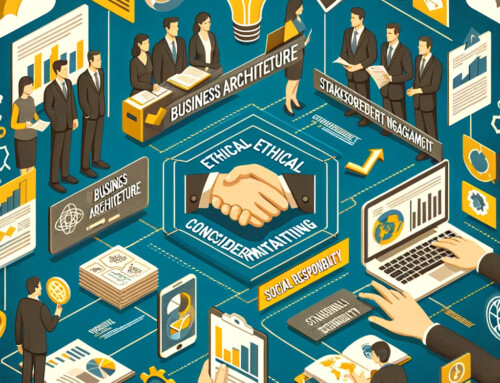Enterprise Architecture (EA) is a strategic planning process that aligns business and technology, ensures that investments are driven by business strategy, and that the company is well-structured to achieve its mission. This discipline has a variety of deliverables, which are created for different stakeholders to fulfill various objectives.
A friendly warning, though: Focusing on outcomes, not artifacts, is vital. Drowning in deliverables does not move the needle. Here’s a comprehensive list of possible enterprise architecture deliverables:
Enterprise Architecture Deliverables
- Enterprise Architecture Blueprint
-
- What it is: An Enterprise Architecture Blueprint is a detailed diagram or set of diagrams representing the structure and relationships of the core business, data, applications, and technology elements within an organization.
- Why it’s essential: It offers a holistic view of the enterprise, helping stakeholders understand how various components are interrelated. This helps make decisions, reduces redundancy, increases consistency, and enhances coordination across business units.
- How to create it:
-
-
- Understand the organization’s goals, strategic drivers, and transformational needs.
- Identify and classify all business components, including business functions, data, applications, and technology.
- Map relationships and dependencies between these components.
- Represent the details visually, often using an architecture modeling tool.
-
- Enterprise Architecture Strategy
-
- What it is: This document provides an overall approach to designing, implementing, and maintaining the enterprise architecture. It outlines the architecture principles, framework, tools, and methods.
- Why it’s essential: It ensures alignment of the enterprise architecture practice with business strategy and provides clear guidance to all stakeholders on managing the architecture.
- How to create it:
-
-
- Understand the business strategy and goals.
- Determine the architectural principles that will guide the practice. These could be related to standardization, modularity, flexibility, and security.
- Select the architecture framework (e.g., TOGAF, Zachman).
- Identify the architecture modeling tools and methods that will be used to create and manage architecture artifacts.
- Document all the above in a clear and concise strategy document.
-
- Roadmaps
-
- What it is: Roadmaps are plans that outline the transformation journey from the current architecture state to the desired future state. This might include technology, application, and business process roadmaps.
- Why it’s important: They provide clear steps to achieve the desired architecture state, help coordinate efforts across the organization, and ensure that progress can be tracked and managed.
- How to create it:
-
-
- Understand the current architecture state.
- Define the desired future state of the architecture.
- Identify the gaps between the current and future state.
- Develop a plan to bridge these gaps over time, considering resource availability, business priorities, and risk tolerance.
- Document the plan in a roadmap that clearly outlines the steps to be taken, the expected timeframe, and the resources needed.
-
Which of these Enterprise Architecture Deliverables does your EA team produce? Are we missing any vital Enterprise Architecture Deliverables in this list?
- Standards and Guidelines
-
- What it is: These are documented rules for using and managing various architectural components. This could include data standards, software development guidelines, and technology standards.
- Why it’s important: They ensure consistency, improve interoperability, reduce redundancy, and improve the quality and performance of the enterprise architecture.
- How to create it:
-
-
- Understand the requirements and constraints of the organization.
- Identify best practices and industry standards relevant to the organization.
- Develop specific rules and guidelines based on these practices and standards.
- Document the rules in a clear, easy-to-understand format.
- Implement a process for updating and managing these rules as the organization and its environment evolve.
-
- Project and Program Architectural Requirements
-
- What it is: These are detailed documents specifying the architectural requirements for a given project or program. They define the structural, behavioral, and non-functional requirements the architecture of the project or program must fulfill.
- Why it’s important: They provide clear guidelines for developing and implementing projects or programs, ensuring they align with the overall enterprise architecture and business objectives.
- How to create it:
-
-
- Understand the business and technical objectives of the project or program.
- Analyze these objectives and translate them into specific architectural requirements.
- Consult with stakeholders, such as business owners, users, and architects, to validate and refine these requirements.
- Document the requirements clearly in a structured format, preferably using a standardized template.
-
- Architecture Review Reports
-
- What it is: Reports detailing the findings of architectural reviews are conducted to assess a project or program’s adherence to the enterprise architecture.
- Why it’s important: They ensure that the project or program is aligned with the overall enterprise architecture, identify potential issues early, and provide recommendations for improvements.
- How to create it:
-
-
- Establish criteria to evaluate the project or program against the enterprise architecture.
- Conduct the review, assessing the structure, design, technology, and interoperability.
- Document the findings, including areas of alignment, non-compliance, and potential risks.
- Provide recommendations for alignment and improvement.
-
- Gap Analysis Reports
-
- What it is: These reports highlight the gaps between the current and desired state of the enterprise architecture.
- Why it’s important: They help identify areas of improvement and serve as a basis for developing a roadmap for transitioning from the current to the future state.
- How to create it:
-
-
- Understand the current state of the enterprise architecture.
- Define the desired future state of the architecture.
- Identify the gaps between the current and future state.
- Analyze the implications of these gaps and their potential impact on the business.
- Document the findings in a structured gap analysis report.
-
- Business Capability Maps
-
- What it is: Graphical representations of the organization’s business capabilities and how they relate.
- Why it’s essential: They clearly understand what the organization can do, help identify redundancies and gaps, and align capabilities with the business strategy and architecture.
- How to create it:
-
-
- Identify the key capabilities of the business, which could include operations, customer service, product development, etc.
- Organize these capabilities in a hierarchical structure, starting with high-level capabilities and breaking them down into more specific ones.
- Map the relationships between these capabilities.
- Represent these capabilities and their relationships in a visual diagram.
-
- Data Architecture Diagrams and Models
-
- What it is: Visual representations of the organization’s data entities, their relationships, and flows.
- Why it’s essential: They clearly understand the data landscape, support data governance, and guide the design and development of data-intensive applications.
- How to create it:
-
-
- Identify the critical data entities within the organization.
- Define the relationships between these entities.
- Map the flow of data between these entities.
- Use a data modeling tool to represent these entities, relationships, and flows visually.
-
- Application Architecture Diagrams and Models
-
- What it is: Visual representations of the organization’s software applications, their relationships, and how they support business processes and functions.
- Why it’s important: They help understand the application landscape, guide the development and integration of applications, and support IT planning and decision-making.
- How to create it:
-
-
- Identify the critical applications within the organization.
- Understand the functionality of each application and how it supports business processes and functions.
- Define the relationships and dependencies between these applications.
- Use an architecture modeling tool to represent these applications and their relationships visually.
-
- Technology or Infrastructure Architecture Diagrams and Models
-
- What it is: These are visual representations of the organization’s hardware, software, networks, and other technology or infrastructure components and how they interact.
- Why it’s important: They provide an overview of the organization’s technological landscape, help with IT decision-making and planning, and ensure alignment with business goals.
- How to create it:
-
-
- Identify the critical technology or infrastructure components within the organization.
- Understand how these components interact with each other.
- Define the relationships between these components.
- Use an architecture modeling tool to represent these components and their relationships visually.
-
- Business Process Models
-
- What it is: These models represent the detailed flows of the organization’s business processes, including triggers, activities, outcomes, and roles responsible.
- Why it’s important: They help to understand, analyze, and improve business processes and ensure alignment with the organization’s goals and architecture.
- How to create it:
-
-
- Identify the business processes that need to be modeled.
- Understand each process’s triggers, activities, outcomes, and roles.
- Map out the flow of each process, using standard symbols to represent different activities and flow control elements.
- Use a business process modeling tool to create a visual diagram of these flows.
-
- Risk Assessment Reports
-
- What it is: These are evaluations of risks involved with implementing specific architecture components or gaps present in the current state.
- Why it’s important: They help to identify, evaluate, and manage risks, thus supporting decision-making, planning, and governance activities.
- How to create it:
-
-
- Identify the potential risks associated with the architecture or its implementation.
- Assess the impact and likelihood of each risk using a risk assessment matrix or similar tool.
- Define potential mitigation strategies for each risk.
- Document the results in a structured risk assessment report.
-
- Governance Documents
-
- What it is: These documents outline the responsibilities and roles within the enterprise architecture practice, processes to manage changes to the architecture, and procedures for architecture compliance.
- Why it’s important: They provide clear guidelines for managing the enterprise architecture practice, ensuring accountability, consistency, and alignment with business goals.
- How to create it:
-
-
- Define the roles and responsibilities within the architecture practice.
- Establish the processes for managing changes to the architecture.
- Define the procedures for ensuring compliance with the architecture.
- Document all the above in a clear and concise governance document.
-
- Metrics and Performance Reports
-
- What it is: Reports on the effectiveness of the architecture, usually based on specific Key Performance Indicators (KPIs) that align with the organization’s strategic objectives.
- Why it’s important: They provide insights into the architecture’s performance, supporting decision-making, planning, and continuous improvement efforts.
- How to create it:
-
-
- Define the KPIs that will be used to measure the architecture’s performance.
- Collect data on these KPIs over a defined period.
- Analyze the data to assess the performance of the architecture.
- Document the results in a structured performance report.
-
- Architectural Decisions Log
-
- What it is: A document outlining critical decisions in the architecture’s development, maintenance, and implementation.
- Why it’s important: It helps to track and justify decisions made, providing transparency, supporting governance activities, and serving as a reference for future decision-making.
- How to create it:
-
-
- Whenever a decision is related to the architecture, record it, its reason, and the alternatives considered.
- Document the impact of the decision on the architecture and the business.
- Regularly update the log as new decisions are made.
- Ensure that the log is easily accessible and understood by all relevant stakeholders.
-
Remember, not every deliverable is required in every situation. The specific deliverables needed would depend on the scope, objectives, and maturity of the enterprise architecture in the organization.


